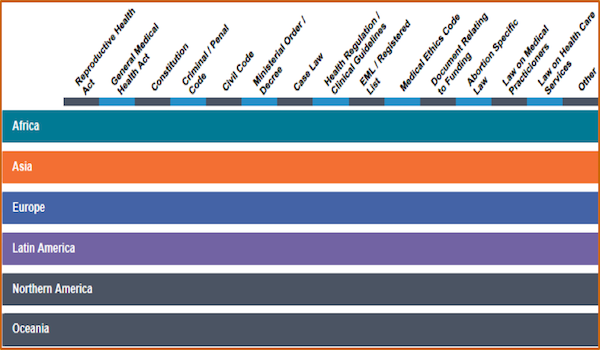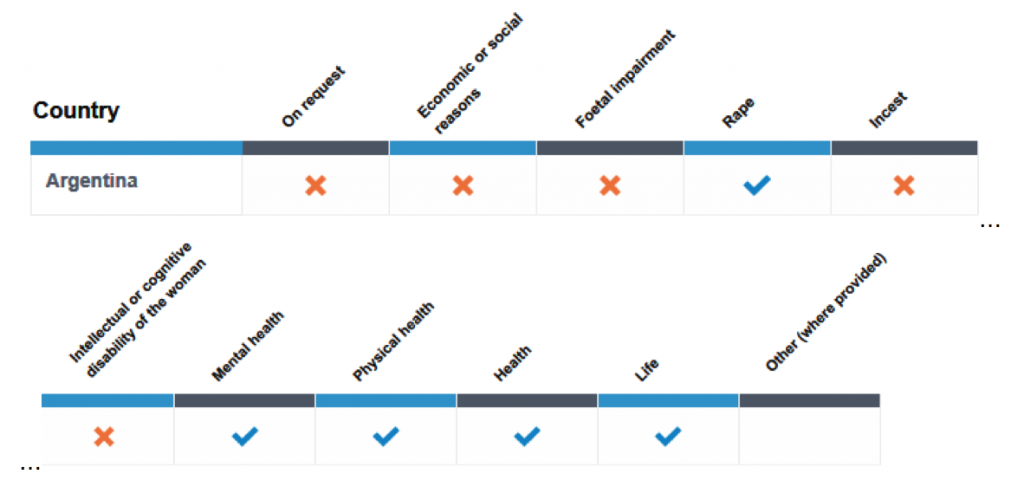
In 2002, the Population Division of the United Nations Department of Economic and Social Affairs (UN DESA) published an online database summarising the world’s abortion laws and policies, which they had tracked since the mid-1990s. It was a fantastic achievement and has continued to be of great use, in spite of the absence of updates since it was published (You just needed to know from other sources that a specific country had changed its abortion law/policies after 2002 and you could supplement the information it gave you). As a narrative source of the history of abortion laws and policies in each country, it should remain a valuable link to consult for a very long time.
Now, since June 2017, a new database has been placed online, which is full of the most up-to-date information. We published a short announcement about this new database in last week’s newsletter. Here are more details about it.
The new database was developed by staff at the Special Programme of Research, Development and Research Training in Human Reproduction (HRP), who are based at the World Health Organization (WHO) in Geneva. HRP is a joint programme of the UN Development Programme, UN Population Fund, UN Children’s Fund, WHO, and the World Bank.
HRP staff worked in collaboration with the Population Division of UN DESA to develop this new, open-access Global Abortion Policies Database. Beginning in early 2015, they engaged several research partners to retrieve the collected information. Selected data were extracted onto a policy questionnaire that was rigorously cross-checked by public health and law experts and sent to countries for review.
The database is available at two different web interfaces, which in appearance are quite different from each other:
- one managed by WHO (http://www.srhr.org/abortion-policies) and
- one managed by UN DESA (https://esa.un.org/gapp).
The main objectives of the database are to promote greater transparency of abortion laws and policies and State accountability for the protection of women and girls’ health and human rights. It includes comprehensive information for all WHO and UN Member States on abortion laws, policies, health standards and guidelines as stated in the original source documents, with notes that provide details on unique policy nuances. It also includes country-specific sexual and reproductive health indicators.
The database is intended for use by policy-makers, human rights bodies, non-governmental organizations, public health researchers and civil society.
Enter either of these interfaces intending to take a good look around and spend time to figure out how it works. Both interfaces are packed not only with detailed information about each country but also a range of options for deciding how much and what kind of information you want. You can see data on one topic for all countries (such as legal grounds for abortion), or data on one or more selected topics for one country, or data for a selection of countries at one time, e.g. for a whole region.
The database can help users to compare abortion laws and policies to the WHO guidelines, as well as between countries and geographical regions. It can also facilitate understanding of the complexities and nuances of laws and policies that were not addressed previously or were obscured behind more simplistic classification schemes.
**************************************************************
Policy domains highlighted in the Database
- Abortion – legal grounds and related gestational age limits
- Other legal requirements for abortion access
- Third-party authorizations (parents, spouses, health-care providers, courts)
- Police reports for rape
- Compulsory counselling
- Mandatory waiting periods
- Medically unnecessary screening tests
- Who can be criminally charged and associated penalties for unlawful abortion
- Restrictions on public information about abortion
- National standards for abortion care
- Existence of service-delivery guidelines
- Who can provide abortion services
- Where abortion can be provided
- Methods permitted
- National insurance coverage for abortion
- Registration of mifepristone and/or misoprostol
- Policies on conscientious objection
The HRP platform juxtaposes relevant policy data with information and recommendations from WHO. In addition, country profiles include penalties, ratified human rights treaties, and extracts from UN treaty monitoring body concluding observations and special procedures on abortion.
The UN DESA interface has not yet been completed at this writing; you may find it leads to pages that still say “Work in progress”.
Read more about this resource on HRP’s web pages here: https://goo.gl/v7TGTG
*******************************************************
An example from the WHO interface: Argentina
at: http://srhr.org/abortion-policies/country/argentina/
Region: South America
Last Update in Database: 7 May 2017
Identified policies and legal sources related to abortion:
Criminal/Penal Code
Case Law
Health Regulation/Clinical Guideline
EML/Registered List
Other
Persons who can be sanctioned:
A woman or girl can be sanctioned
Providers can be sanctioned
A person who assists can be sanctioned
Legal grounds for abortion

Additional requirements to access safe abortion

i = no information found
*******************************************************
What the database does not do
The database does not address how laws and policies are applied in practice, so users interested in progressive policy reform to protect women and girls’ health and human rights are encouraged to generate evidence on how laws and policies are applied in practice and implemented.
Please send updates, corrections and feedback
All users are invited to provide suggestions for updates, corrections and feedback using the contact form available at the database websites. Please use this Contact form. HRP will make every effort to keep the database accurate and current.
SOURCES: WHO interface, Global Abortion Policies Database, accessed 4 July 2017
+ Brooke Ronald Johnson Jr, Vinod Mishra, Antonella Francheska Lavelanet, Rajat Khosla, Bela Ganatra. A global database of abortion laws, policies, health standards and guidelines. Bulletin of World Health Organization 2017;95:542–44. doi: http://dx.doi.org/10.2471/BLT.17.197442



